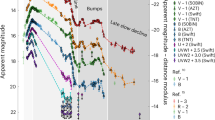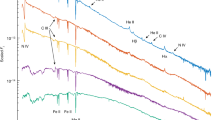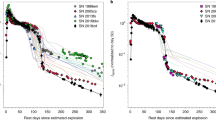Abstract
The interaction of a supernova with a circumstellar medium (CSM) can dramatically increase the emitted luminosity by converting kinetic energy to thermal energy. In ‘superluminous’ supernovae of type IIn—named for narrow hydrogen lines1 in their spectra—the integrated emission can reach2,3,4,5,6 ~1051 erg, attainable by thermalizing most of the kinetic energy of a conventional supernova. A few transients in the centres of active galaxies have shown similar spectra and even larger energies7,8, but are difficult to distinguish from accretion onto the supermassive black hole. Here we present a new event, SN2016aps, offset from the centre of a low-mass galaxy, that radiated ≳5 × 1051 erg, necessitating a hyper-energetic supernova explosion. We find a total (supernova ejecta + CSM) mass likely exceeding 50−100 M⊙, with energy ≳1052 erg, consistent with some models of pair-instability supernovae or pulsational pair-instability supernovae—theoretically predicted thermonuclear explosions from helium cores >50 M⊙. Independent of the explosion mechanism, this event demonstrates the existence of extremely energetic stellar explosions, detectable at very high redshifts, and provides insight into dense CSM formation in the most massive stars.
This is a preview of subscription content, access via your institution
Access options
Access Nature and 54 other Nature Portfolio journals
Get Nature+, our best-value online-access subscription
$29.99 / 30 days
cancel any time
Subscribe to this journal
Receive 12 digital issues and online access to articles
$119.00 per year
only $9.92 per issue
Buy this article
- Purchase on Springer Link
- Instant access to full article PDF
Prices may be subject to local taxes which are calculated during checkout




Similar content being viewed by others
Data availability
All data are publicly available via the Open Supernova Catalog61 (https://sne.space) and the Weizmann Interactive SN Repository80 (https://wiserep.weizmann.ac.il).
Code availability
MOSFiT is publicly available at https://github.com/guillochon/MOSFiT. SuperBol is publicly available at https://github.com/mnicholl/superbol.
References
Schlegel, E. M. A new subclass of type II supernovae? Mon. Not. R. Astron. Soc. 244, 269–271 (1990).
Smith, N. et al. SN 2006gy: discovery of the most luminous supernova ever recorded, powered by the death of an extremely massive star like η Carinae. Astrophys. J. 666, 1116 (2007).
Drake, A. et al. Discovery of the extremely energetic supernova 2008fz. Astrophys. J. 718, L127 (2010).
Chatzopoulos, E. et al. SN 2008am: a super-luminous type IIn supernova. Astrophys. J. 729, 143 (2011).
Rest, A. et al. Pushing the boundaries of conventional core-collapse supernovae: the extremely energetic supernova SN 2003ma. Astrophys. J. 729, 88 (2011).
Benetti, S. et al. The supernova CSS121015:004244+132827: a clue for understanding superluminous supernovae. Mon. Not. R. Astron. Soc. 441, 289–303 (2014).
Blanchard, P. K. et al. PS16dtm: a tidal disruption event in a narrow-line Seyfert 1 galaxy. Astrophys. J. 843, 106 (2017).
Kankare, E. et al. A population of highly energetic transient events in the centres of active galaxies. Nat. Astron. 1, 865–871 (2017).
Huber, M. et al. The Pan-STARRS Survey for Transients (PSST)—first announcement and public release. The Astronomer’s Telegram 7153 (2015).
Chornock, R. et al. Spectroscopic classification of two superluminous supernovae. The Astronomer’s Telegram 8790 (2016).
Law, N. M. et al. The Palomar Transient Factory: system overview, performance, and first results. Publ. Astron. Soc. Pac. 121, 1395 (2009).
Dong, S. et al. ASASSN-15lh: a highly super-luminous supernova. Science 351, 257–260 (2016).
Smith, N. et al. SN 2006tf: precursor eruptions and the optically thick regime of extremely luminous type IIn supernovae. Astrophys. J. 686, 467 (2008).
Fransson, C. et al. High-density circumstellar interaction in the luminous type IIn SN 2010jl: the first 1100 days. Astrophys. J. 797, 118 (2014).
Sukhbold, T. & Woosley, S. E. The most luminous supernovae. Astrophys. J. 820, L38 (2016).
Chevalier, R. A. & Irwin, C. M. Shock breakout in dense mass loss: luminous supernovae. Astrophys. J. 729, L6 (2011).
Chugai, N. N. & Danziger, I. J. SN 1988Z: low-mass ejecta colliding with the clumpy wind? Mon. Not. R. Astron. Soc. 268, 173–180 (1994).
Chevalier, R. A. & Irwin, C. M. X-rays from supernova shocks in dense mass loss. Astrophys. J. 747, L17 (2012).
Mackey, J. et al. Interacting supernovae from photoionization-confined shells around red supergiant stars. Nature 512, 282–285 (2014).
Vink, J. S. Fast and slow winds from supergiants and luminous blue variables. Astron. Astrophys. 619, A54 (2018).
Chatzopoulos, E., Wheeler, J. C. & Vinko, J. Generalized semi-analytical models of supernova light curves. Astrophys. J. 746, 121 (2012).
Guillochon, J. et al. MOSFiT: modular open source fitter for transients. Astrophys. J. Suppl. 236, 6 (2018).
Dessart, L., Audit, E. & Hillier, D. J. Numerical simulations of superluminous supernovae of type IIn. Mon. Not. R. Astron. Soc. 449, 4304–4325 (2015).
Woosley, S. E. Pulsational pair-instability supernovae. Astrophys. J. 836, 244 (2017).
Gomez, S. et al. SN 2016iet: the pulsational or pair instability explosion of a low-metallicity massive CO core embedded in a dense hydrogen-poor circumstellar medium. Astrophys. J. 881, 87 (2019).
Vigna-Gómez, A., Justham, S., Mandel, I., de Mink, S. E. & Podsiadlowski, P. Massive stellar mergers as precursors of hydrogen-rich pulsational pair instability supernovae. Astrophys. J. 876, L29 (2019).
Yan, L. et al. Hydrogen-poor superluminous supernovae with late-time Hα emission: three events from the intermediate Palomar Transient Factory. Astrophys. J. 848, 6 (2017).
Lunnan, R. et al. A UV resonance line echo from a shell around a hydrogen-poor superluminous supernova. Nat. Astron. 2, 887–895 (2018).
Chen, T. W. et al. SN 2017ens: the metamorphosis of a luminous broadlined type Ic supernova into an SN IIn. Astrophys. J. 867, L31 (2018).
Kasen, D., Woosley, S. E. & Heger, A. Pair instability supernovae: light curves, spectra, and shock breakout. Astrophys. J. 734, 102 (2011).
Chatzopoulos, E. & Wheeler, J. C. Hydrogen-poor circumstellar shells from pulsational pair-instability supernovae with rapidly rotating progenitors. Astrophys. J. 760, 154 (2012).
Cooke, J. et al. Superluminous supernovae at redshifts of 2.05 and 3.90. Nature 491, 228–231 (2012).
Martini, P. et al. The Ohio State Multi-object Spectrograph. Publ. Astron. Soc. Pac. 123, 187 (2011).
Fabricant, D., Cheimets, P., Caldwell, N. & Geary, J. The FAST spectrograph for the tillinghast telescope. Publ. Astron. Soc. Pac. 110, 79–85 (1998).
Schmidt, G. D., Weymann, R. J. & Foltz, C. B. A moderate-resolution, high-throughput CCD channel for the MMT spectrograph. Publ. Astron. Soc. Pac. 101, 713 (1989).
Hook, I. M. et al. The Gemini-North Multi-Object Spectrograph: performance in imaging, long-slit, and multi-object spectroscopic modes. Publ. Astron. Soc. Pac. 116, 425–440 (2004).
Oke, J. B. et al. The Keck low-resolution imaging spectrometer. Publ. Astron. Soc. Pac. 107, 375 (1995).
Perley, D. A. Fully automated reduction of longslit spectroscopy with the low resolution imaging spectrometer at the Keck Observatory. Publ. Astron. Soc. Pac. 131, 084503 (2019).
Schlafly, E. F. & Finkbeiner, D. P. Measuring reddening with Sloan Digital Sky Survey stellar spectra and recalibrating SFD. Astrophys. J. 737, 103 (2011).
Planck Collaboration. et al Planck 2015 results. XIII. Cosmological parameters. Astron. Astrophys. 594, A13 (2016).
Smith, N., Chornock, R., Silverman, J. M., Filippenko, A. V. & Foley, R. J. Spectral evolution of the extraordinary type IIn supernova 2006gy. Astrophys. J. 709, 856–883 (2010).
Savitzky, A. & Golay, M. J. E. Smoothing and differentiation of data by simplified least squares procedures. Anal. Chem. 36, 1627–1639 (1964).
Flewelling, H. et al. The Pan-STARRS1 Database and Data Products. Preprint at https://arxiv.org/abs/1612.05243 (2016).
Magnier, E.A. et al. The Pan-STARRS Data Processing System. Preprint at https://arxiv.org/abs/1612:05240 (2016).
Rahmer, G. et al. The 12Kx8K CCD mosaic camera for the Palomar Transient Factory. Proc. SPIE 7014, 70144Y (2008).
Law, N. M. et al. The Palomar Transient Factory: system overview, performance, and first results. Publ. Astron. Soc. Pac. 121, 1395–1408 (2009).
Masci, F. J. et al. The IPAC Image Subtraction and Discovery Pipeline for the intermediate Palomar Transient Factory. Publ. Astron. Soc. Pac. 129, 014002 (2017).
Ofek, E. O. et al. The Palomar Transient Factory photometric calibration. Publ. Astron. Soc. Pac. 124, 62–73 (2012).
Brown, P. J. et al. Ultraviolet light curves of supernovae with the Swift ultraviolet/optical telescope. Astron. J. 137, 4517–4525 (2009).
Breeveld, A. A. et al. An updated ultraviolet calibration for the Swift/UVOT. AIP Conf. Ser. 1358, 373–376 (2011).
Lunnan, R. et al. Hydrogen-poor superluminous supernovae and long-duration gamma-ray bursts have similar host galaxies. Astrophys. J. 787, 138 (2014).
Poznanski, D., Prochaska, J. X. & Bloom, J. S. An empirical relation between sodium absorption and dust extinction. Mon. Not. R. Astron. Soc. 426, 1465–1474 (2012).
Inserra, C. et al. On the nature of hydrogen-rich superluminous supernovae. Mon. Not. R. Astron. Soc. 475, 1046–1072 (2018).
Ofek, E. et al. SN 2006gy: an extremely luminous supernova in the galaxy NGC 1260. Astrophys. J. 659, L13 (2007).
Agnoletto, I. et al. SN 2006gy: was it really extraordinary? Astrophys. J. 691, 1348 (2009).
Miller, A. A. et al. SN 2008iy: an unusual type IIn supernova with an enduring 400-d rise time. Mon. Not. R. Astron. Soc. 404, 305–317 (2010).
Moriya, T. J. et al. HSC16aayt: a slowly evolving interacting transient rising for more than 100 days. Astrophys. J. 882, 70 (2019).
Tartaglia, L. et al. The long-lived type IIn SN 2015da: infrared echoes and strong interaction within an extended massive shell. Astron. Astrophys. 635, A39 (2019).
Arcavi, I. et al. Energetic eruptions leading to a peculiar hydrogen-rich explosion of a massive star. Nature 551, 210–213 (2017).
Terreran, G. et al. Hydrogen-rich supernovae beyond the neutrino-driven core-collapse paradigm. Nat. Astron. 1, 713–720 (2017).
Guillochon, J., Parrent, J., Kelley, L. Z. & Margutti, R. An open catalog for supernova data. Astrophys. J. 835, 64 (2017).
Nicholl, M. SuperBol: A user-friendly Python routine for bolometric light curves. Res. Notes Am. Astron. Soc. 2, 230 (2018).
Gall, C. et al. Rapid formation of large dust grains in the luminous supernova 2010jl. Nature 511, 326–329 (2014).
Bhirombhakdi, K. et al. The type II superluminous SN 2008es at late times: near-infrared excess and circumstellar interaction. Mon. Not. R. Astron. Soc. 488, 3783–3793 (2019).
Margutti, R. et al. Ejection of the massive hydrogen-rich envelope timed with the collapse of the stripped SN 2014C. Astrophys. J. 835, 140 (2017).
Peng, C. Y., Ho, L. C., Impey, C. D. & Rix, H.-W. Detailed structural decomposition of galaxy images. Astron. J. 124, 266–293 (2002).
Andrews, B. H. & Martini, P. The mass–metallicity relation with the direct method on stacked spectra of SDSS galaxies. Astrophys. J. 765, 140 (2013).
Kennicutt, J. & Robert, C. Star formation in galaxies along the Hubble sequence. Annu. Rev. Astron. Astrophys. 36, 189–232 (1998).
Lunnan, R. et al. Zooming in on the progenitors of superluminous supernovae with the HST. Astrophys. J. 804, 90 (2015).
Sana, H. et al. Binary interaction dominates the evolution of massive stars. Science 337, 444 (2012).
Paxton, B. et al. Modules for experiments in stellar astrophysics (MESA). Astrophys. J. Suppl. 192, 3 (2011).
Paxton, B. et al. Modules for experiments in stellar astrophysics (MESA): convective boundaries, element diffusion, and massive star explosions. Astrophys. J. Suppl. 234, 34 (2018).
Yoon, S. C., Langer, N. & Norman, C. Single star progenitors of long gamma-ray bursts. I. Model grids and redshift dependent GRB rate. Astron. Astrophys. 460, 199–208 (2006).
de Mink, S. E., Langer, N., Izzard, R. G., Sana, H. & de Koter, A. The rotation rates of massive stars: the role of binary interaction through tides, mass transfer, and mergers. Astrophys. J. 764, 166 (2013).
Nicholl, M., Guillochon, J. & Berger, E. The magnetar model for type I superluminous supernovae. I. Bayesian analysis of the full multicolor light-curve sample with MOSFiT. Astrophys. J. 850, 55 (2017).
LSST Science Collaboration et al. LSST science book, version 2.0. Preprint at https://arxiv.org/abs/0912.0201 (2009).
Dessart, L., Hillier, D. J., Waldman, R., Livne, E. & Blondin, S. Superluminous supernovae: 56Ni power versus magnetar radiation. Mon. Not. R. Astron. Soc. 426, L76–L80 (2012).
Jerkstrand, A., Smartt, S. J. & Heger, A. Nebular spectra of pair-instability supernovae. Mon. Not. R. Astron. Soc. 455, 3207–3229 (2016).
Nicholl, M. et al. Slowly fading super-luminous supernovae that are not pair-instability explosions. Nature 502, 346–349 (2013).
Yaron, O. & Gal-Yam, A. WISeREP—an interactive supernova data repository. Publ. Astron. Soc. Pac. 124, 668 (2012).
Gal-Yam, A. et al. Supernova 2007bi as a pair-instability explosion. Nature 462, 624–627 (2009).
Acknowledgements
M.N. is a Royal Astronomical Society Research Fellow. The Berger Time-Domain Group acknowledge NSF grant AST-1714498 and NASA grant NNX15AE50G. R.L. acknowledges a Marie Skłodowska-Curie Individual Fellowship within the Horizon 2020 European Union Framework (H2020-MSCA-IF-2017-794467). W.-f.F. and K.P. acknowledge support from NSF grant numbers AST-1814782 and AST-1909358. The Margutti group acknowledges NSF grant number AST 1909796, NASA grants 80NSSC19K0384 and 80NSSC19K0646. A.A.M. is supported by the LSST Corporation, the Brinson Foundation, the Moore Foundation via the LSSTC Data Science Fellowship Program, and the CIERA Fellowship Program. A.V.-G. acknowledges support by the Danish National Research Foundation (DNRF132). Data were obtained via the NASA/ESA Hubble Space Telescope archive at the Space Telescope Science Institute, the Swift archive, the Smithsonian Astrophysical Observatory OIR Data Center, the MMT Observatory, the MDM Observatory, the Gemini Observatory, operated by the Association of Universities for Research in Astronomy, Inc., under agreement with the NSF, and the W.M. Keck Observatory, operated as a partnership among the California Institute of Technology, the University of California, and NASA. Operation of the Pan-STARRS1 telescope is supported by NASA under Grants NNX12AR65G and NNX14AM74G. The authors respect the very significant cultural role of Mauna Kea within the indigenous Hawaiian community.
Author information
Authors and Affiliations
Contributions
M.N. wrote the manuscript, led the analysis and obtained the HST and Gemini data. P.K.B. devised the selection algorithm and identified SN2016aps as an interesting source, and analysed the HST images. E.B. advised on the manuscript and leads the overall project. R.C. and K.B. obtained the MDM spectrum and classified SN2016aps. R.M. analysed the UVOT data. P.K.B., S.G., A.B. and P.C. obtained FLWO data. R.L. obtained the Keck spectra. A.V.-G. did the rate calculations. A.A.M., F.J.M. and R.R.L. provided PTF data. W.-f.F. and P.K.B. obtained MMT imaging. G.T., A.A.M. and K.P. obtained Keck imaging. All authors helped with the interpretation.
Corresponding author
Ethics declarations
Competing interests
The authors declare no competing interests.
Additional information
Publisher’s note Springer Nature remains neutral with regard to jurisdictional claims in published maps and institutional affiliations.
Supplementary information
Extended Data Fig. 1 Bolometric light curve of SN2016aps.
Top: Comparison of the bolometric light curve to other SLSNe IIn. The integrated luminosity is greater than any previously known SN. Middle: Temperature evolution from blackbody fits (Methods). Bottom: Photospheric radius from blackbody fits. Error bars show 1σ uncertainties.
Extended Data Fig. 2 Fit to the light curve of SN2016aps with MOSFIT using a wind-like density profile.
(a) For fixed parameters based on simple scaling relations (see Supplementary Information). The fit is reasonable overall but systematically under-predicts the UV bands. (b) Realizations of a full MCMC fit. This matches the UV but favours masses larger by a factor ~ 3. Posteriors of the model parameters are given in Extended Data Fig. 3. Error bars show 1σ uncertainties.
Extended Data Fig. 3 Posteriors for physical parameters inferred using the MOSFIT CSM model.
Parameters are shown for fits using both shell (ρ=constant; black) and wind (ρ ∝ r−2; blue) density profiles. The additional variance (noise) parameter, σ ~ 0.1, indicates a similar quality of fit independent of the assumed density. Both models favour ejected masses ≳ 100M⊙, with a comparable mass of CSM. Drawing from the joint Mej-vej posteriors gives a kinetic energy Ek ≈ 5 × 1052 erg in both cases.
Extended Data Fig. 4 Simulated observer frame LSST light curves in g,r,i,z bands.
The left column shows our interaction model for SN2016aps, while the right column shows a radioactively-powered PISN model for a 130 M⊙ helium core (Methods). The rows show the same models at redshifts z=0.1, 0.5, 0.75, 1 and 1.5. The interacting model is still well detected at z=1.5, because it is bright in the UV (whereas the radioactive model is heavily absorbed by metal lines). Therefore interacting events like SN2016aps are detectable over a volume that is larger by a factor ≳ 7. Error bars show simulated 1σ uncertainties.
Extended Data Fig. 5 Measurements of the Balmer lines.
The equivalent width of Hα increases over the first 300 days as the continuum fades, similar to other Type IIn SNe and SLSNe, before decreasing in the final epoch. The Hα/Hβ ratio is initially consistent with recombination (horizontal line), but at later times increases to >10, indicating collisional excitation. No Hβ could be measured in the final spectrum, the arrow indicates a lower limit on this ratio. Error bars show 1σ uncertainties.
Extended Data Fig. 6 Spectroscopic comparison of SN2016aps to the energetic nuclear transients PS16dtm and PS1-10adi.
PS16dtm is thought to be a TDE [7] and PS1-10adi has been suggested to be a possible SN close to an AGN [8], these two nuclear transients closely resemble each other. The spectra shown here are at around 200 days after maximum light. SN2016aps is distinguished from these events by broader and more symmetrical Balmer lines (lacking a red shoulder), and a lack of strong, narrow Fe II emission. SN2016aps also lacks the [O III] emission seen at 5000Å (see also Supplementary Information). The apparent absorption in PS16dtm at 7000Å is a telluric feature from the Earth’s atmosphere.
Supplementary information
Supplementary Information
Supplementary discussion.
Rights and permissions
About this article
Cite this article
Nicholl, M., Blanchard, P.K., Berger, E. et al. An extremely energetic supernova from a very massive star in a dense medium. Nat Astron 4, 893–899 (2020). https://doi.org/10.1038/s41550-020-1066-7
Received:
Accepted:
Published:
Issue Date:
DOI: https://doi.org/10.1038/s41550-020-1066-7
This article is cited by
-
Core-collapse supernova from a possible progenitor star of 100 \(M_{\odot }\)
Journal of Astrophysics and Astronomy (2022)
-
The evolution of binary neutron star post-merger remnants: a review
General Relativity and Gravitation (2021)



